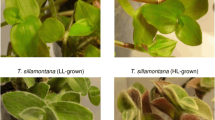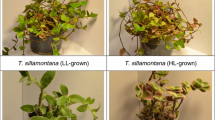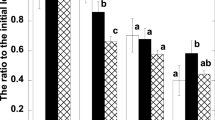Abstract
Chrysanthemum inducum-hybrid `Coral Charm', Hibiscus rosa-sinensis L. `Cairo Red' and Spathiphyllum wallisii Regel `Petit' were grown in natural light in a greenhouse at three levels of irradiance using permanent shade screens. Light acclimation of photosynthesis was characterized using modulated chlorophyll a fluorescence of intact leaves. A close correlation was found between the degree of reduction of the primary electron acceptor QA of Photosystem II (PS II) approximated as the fluorescence parameter 1−qP, and light acclimation. The action range of 1−qP was 0–0.4 from darkness to full irradiance around noon, within the respective light treatments in the greenhouse, indicating that most PS II reaction centres were kept open. In general, the index for electron transport (ETR) measured by chlorophyll fluorescence was higher for high-light (HL) than intermediate-(IL) and low-light (LL) grown plants. However, HL Chrysanthemum showed 40% higher ETR than HL Hibiscus at light saturation, despite identical redox states of QA. The light acclimation of the non-radiative dissipation of excess energy in the antenna, NPQ, varied considerably between the species. However, when normalized against qP, a strong negative correlation was found between thermal dissipation and ETR measured by chlorophyll fluorescence. To be able to accommodate a high flux of electrons through PS II, the plants with the highest light-saturated ETR had the lowest NPQ/qP. The possibility of using chlorophyll fluorescence for quantification of the energy balance between energy input and utilization in PS II in intact leaves is discussed.
Similar content being viewed by others
References
Aaslyng JM, Rosenqvist E and Schmidt KH (1999) A sensor for microclimatic measurement of photosynthetically active radiation in a plant canopy. Agric For Meteor 96: 189–197
Adams III WW and Demmig-Adams B (1992) Operation of the xanthophyll cycle in higher plants in response to diurnal changes in incident sunlight. Planta 186: 390–398
Bilger W and Björkman O (1990) Role of the xanthophyll cycle in photoprotection elucidated by measurements of light-induced absorbance changes, fluorescence and photosynthesis in leaves of Hedera canariensis. Photosynth Res 25: 173–185
Björkman O (1981) Responses to different quantum flux densities. In: Lange OL, Nobel PS, Osmond CB and Ziegler H (eds) Physiological Plant Ecology I, Encyclopedia of Plant Physiology Vol 12A, pp 57–107. Springer-Verlag, Berlin
Björkman O and Demmig B (1987) Photon yield of O2 evolution and chlorophyll fluorescence characteristics at 77 K among vascular plants of diverse origins. Planta 170: 489–504
Björkman O and Holmgren P (1963) Adaptability of the photosynthetic apparatus to light intensity in ecotypes from exposed and shaded habitats. Physiol Plant 16: 889–914
Brugnoli E, Scartazza A, De Dullio MC, Monteverdi MC, Lauteri M and Augusi A (1998) Zeaxanthin and non-photochemical quenching in sun and shade leaves of C3 and C4 plants. Physiol Plant 104: 727–734
Butler WL and Kitajima M (1975) Fluorescence quenching in photosystem II of chloroplasts. Biochim Biophys Acta 376: 116–125
Chow WS and Anderson JM (1987a) Photosynthetic responses of Pisum sativum to an increase in irradiance during growth. I. Photosynthetic activities. Aust J Plant Physiol 14: 1–8
Chow WS and Anderson JM (1987b) Photosynthetic responses of Pisum sativum to an increase in irradiance during growth. II. Thylakoid membrane components. Aust J Plant Physiol 14: 9–19
Dau H (1994) Molecular mechanisms and quantitative models of variable Photosystem II fluorescence. Photochem Photobiol 60: 1–23
Demmig B and Björkman O (1987) Comparison of the effect of excessive light on chlorophyll fluorescence (77 K) and photon yield of O2 evolution in leaves of higher plants. Planta 171: 171–184
Demmig-Adams B and Adams III WW (1992) Photoprotection and other responses of plants to high light stress. Annu Rev Plant Physiol Plant Mol Biol 43: 599–626
Dietz K-J, Schreiber U and Heber U (1985) The relationship between the redox state of QA and photosynthesis in leaves at various carbon-dioxide, oxygen and light regimes. Planta 166: 219–226
Durnford DG and Falkowski PG (1997) Chloroplast redox regulation of nuclear gene transcription during photoacclimation. Photosynth Res 53: 229–241
Foyer CH and Harbinson J (1994) Oxygen metabolism and the regulation of photosynthetic electron transport. In: Foyer CH and Mullineaux PM (eds) Causes of Photooxidative Stress and Amelioration of the Defense Systems in Plants, pp 1–42. CRC Press, Boca Raton, Florida
Genty B and Harbinson J (1996) Regulation of light utilizatin for photosynthetic electron transporta. In: Baker NR (ed) Photosynthesis and the Environment, pp 67–99. Kluwer Academic Publishers, Dordrecht, The Netherlands
Genty B, Briantais J-M and Baker NR (1989) The relationship between quantum yield of photosynthetic electron transport and quenching of chorophyll flourescence. Biochim Biophys Acta 990: 87–92
Govindjee (1995) Sixty-three years since Kautsky: Chlorophyll a fluorescence. Aust J Plant Physiol 22: 131–160.
Harbinson J and Hedley CL (1989) The kinetics of P-700+ reduction in leaves: A novel in situ probe of thylakoid functioning. Plant Cell Environ 12: 357–369.
Harbinson J, Genty B and Baker, NR (1989) Relationship between the quantum efficiencies of photosystems I and II in pea leaves. Plant Physiol 90: 1029–1034
Horton P and Hauge A (1988) Studies on the induction of chlorophyll fluorescence in isolated barley protoplasts. IV. Resolution of non-photochemical quenching. Biochim Biophys Acta 932: 107–115
Horton P, Ruban AV, Rees D, Pascal AA, Noctor g and Young AJ (1991) Control of the light-harvesting function of chloroplast membranes by aggregation of the LHC II chlorophyll-protein complex. FEBS Lett 292: 1–4
Huner NPA, Maxwell DP, Gray GR, Savitch LV, Krol m, Ivanov AG and Falk S (1996) Sensing evironmental temperature change through imbalances between energy supply and energy consumption: Redox state of Photosystem II. Physiol Plant 98: 358–364
Johnson GN, Scholes JD, Horton P and Young AJ (1993a) Relationship between carotenoid composition and growth habit in British plant species. Plant Cell Environ 16: 681–686
Johnson GN, Young AJ and Horton P (1994) Activation of nonphotochemical quenching in thylakoids and leaves. Planta 194: 550–556
Johnson GN, Young AJ, Scholes JD and Horton P (1993b) The dissipation of excess excitation energy in British plant species. Plant Cell Environ 16: 673–679
Krall JP and Edwards GE (1992) Relationship between Photosystem II activity and CO2 fixation in leaves. Physiol Plant 86: 180–187
Kroon BMA (1994) Variability of Photosystem II quantum yield and related processes in Chlorella pyrenoidosa (Chlorophyta) acclimated to an oscillating light regime simulating a mixed photic zone. J Phycol 30: 841–852
Kull O and Kruijt B (1999) Acclimation of photosynthesis to light: a mechanistic approach. Funct Ecol 13: 24–36
Lavergne J and Trissl H-W (1995) Theory of fluorescence induction in Photosystem II: Derivation of analytical expressions in a model including exciton-radical-pair equilibrium and restricted energy transfer between photosynthetic units. Biophys J 68: 2474–2492
Leong T-Y and Anderson JM (1984) Adaptation of the thylakoid membranes ot pea chloroplasts to light intensitiy. II. Regulation of electron transport capacities, electron carriers, coupling factor (CF1) activity and rates of photosynthesis. Photosynth Res 5: 117–128
Melis A and Brown JS (1980) Stoichiometry of system I and II reaction centers and of plastoquinone in different photosynthetic membranes. Proc Natl Acad Sci 77: 4712–4716
Ögren E (1991) Prediction of photoinhibition of photosynthesis from measurements of fluorescence quenching components. Planta 184: 538–544
Ögren E and Evans JR (1993)Photosynthetic light-response curves. I. The influence of CO2 partial pressure and leaf inversion. Planta 189: 182–190
Öquist G, Chow WS and Anderson JM (1992) Photoinhibition of photosynthesis represents a mechanism for the long-term regulation of Photosystem II. Planta 186: 450–460
Osmond CB (1994) What is photoinhibition? Some insights from comparisons of shade and sun plants. In: Baker NR and Bowyer JR (eds) Photoinhibition of Photosynthesis: From Molecular Mechanisms to Field, Environmental Plant Biology, pp 1–24. BIOS, Oxford
Osmond CB, Ramus J, Levavasseur G, Franklin LA and Henley WJ (1993) Fluorescence quenching during photosynthesis and photoinhibition of Ulva rotundata Blid. Planta 190: 97–106
Park Y-I, Chow WS and Anderson JM(1995b) The quantum yield of photoinactivation of Photosystem II in pea leaves is greater at low than high photon exposure. Plant Cell Physiol 36: 1163–1167
Park Y-I, Chow WS, Anderson JM and Hurry VM (1996) Differential susceptibility of Photosystem II to light stress in light-acclimated pea leaves depends on the capacity for photochemical and non-radiative dissipation of light. Plant Sci 115: 137–149
Ruban AV and Horton P (1995) Regulation of non-photochemical quenching of chlorophyll fluorescence in plants. Aust J Plant Physiol 22: 221–230
Ruban AV, Young AJ and Horton P (1993) Induction of nonphotochemical energy dissipation and absorbance changes in leaves. Evidence for changes in the state of the light-harvesting system of Photosystem II in vivo. Plant Physiol 102: 741–750
Schreiber U, Bilger W and Neubauer C (1994) Chlorophyll fluorescence as a nonintrusive indicator for rapid assessment of in vivo photosynthesis. In: Schulze E-D and Caldwell MM (eds) Ecophysiology of Photosynthesis, Ecological Studies, Vol 100, pp 48–70. Springer-Verlag, Berlin
Trissl HW and Lavergne J (1995) Fluorescence induction from Photosystem II: Analytical equations for the yield of photochemistry and fluorescence derived from analysis of a model including exciton-radical pair equilibrium and restricted energy transfer between photosynthetic units. Aust J Plant Physiol 22: 183–193
van Kooten O and Snel JFH (1990) The use of chlorophyll flourescence nomenclature in plant stress physiology. Photosynth Res 25: 147–150
Walters RG and Horton P (1991) Resolution of components of non-photochemical chlorophyll fluorescence quenching in barley leaves. Photosynth Res 27: 121–133
Walters RG and Horton P (1993) Theoretical assessment of alternative mechanisms for non-photochemical quenching of PS II fluorescence in barley leaves. Photosynth Res 46: 119–139
Author information
Authors and Affiliations
Rights and permissions
About this article
Cite this article
Rosenqvist, E. Light acclimation maintains the redox state of the PS II electron acceptor Q2 within a narrow range over a broad range of light intensities. Photosynthesis Research 70, 299–310 (2001). https://doi.org/10.1023/A:1014742422775
Issue Date:
DOI: https://doi.org/10.1023/A:1014742422775




